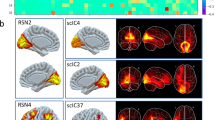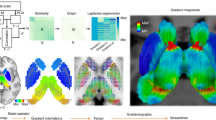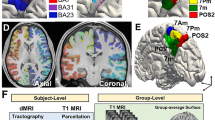Abstract
Integrating the underlying brain circuit's structural and functional architecture is required to explore the functional organization of cognitive networks. In that regard, we recently introduced the Functionnectome. This structural–functional method combines an fMRI acquisition with tractography-derived white matter connectivity data to map cognitive processes onto the white matter. However, this multimodal integration faces three significant challenges: (1) the necessarily limited overlap between tractography streamlines and the grey matter, which may reduce the amount of functional signal associated with the related structural connectivity; (2) the scrambling effect of crossing fibers on functional signal, as a single voxel in such regions can be structurally connected to several cognitive networks with heterogeneous functional signals; and (3) the difficulty of interpretation of the resulting cognitive maps, as crossing and overlapping white matter tracts can obscure the organization of the studied network. In the present study, we tackled these problems by developing a streamline-extension procedure and dividing the white matter anatomical priors between association, commissural, and projection fibers. This approach significantly improved the characterization of the white matter involvement in the studied cognitive processes. The new Functionnectome priors produced are now readily available, and the analysis workflow highlighted here should also be generalizable to other structural–functional approaches.
Graphical abstract
We improved the Functionnectome approach to better study the involvement of white matter in brain function by separating the analysis of the three classes of white matter fibers (association, commissural, and projection fibers). This step successfully clarified the activation maps and increased their statistical significance.










Similar content being viewed by others
Availability of data and materials
All the raw anatomical and functional data are available on the HCP website (https://db.humanconnectome.org/). The unthresholded z-maps are freely available on Neurovault (https://identifiers.org/neurovault.collection:13538). The anatomical priors are freely available with the Functionnectome toolbox (https://github.com/NotaCS/Functionnectome).
References
Aralasmak A, Ulmer JL, Kocak M, Salvan CV, Hillis AE, Yousem DM (2006) Association, commissural, and projection pathways and their functional deficit reported in literature. J Comput Assist Tomogr 30(5):695–715. https://doi.org/10.1097/01.rct.0000226397.43235.8b
Bandettini PA (2012) Twenty years of functional MRI: the science and the stories. Neuroimage 62(2):575–588. https://doi.org/10.1016/j.neuroimage.2012.04.026
Calamante F (2017) Track-weighted imaging methods: extracting information from a streamlines tractogram. MAGMA 30(4):317–335. https://doi.org/10.1007/s10334-017-0608-1
Catani M, Thiebaut de Schotten M (2012) Atlas of Human Brain Connections. Oxford University Press,
Conturo TE, Lori NF, Cull TS, Akbudak E, Snyder AZ, Shimony JS, McKinstry RC, Burton H, Raichle ME (1999) Tracking neuronal fiber pathways in the living human brain. Proc Natl Acad Sci U S A 96(18):10422–10427. https://doi.org/10.1073/pnas.96.18.10422
Dhollander T, Clemente A, Singh M, Boonstra F, Civier O, Duque JD, Egorova N, Enticott P, Fuelscher I, Gajamange S, Genc S, Gottlieb E, Hyde C, Imms P, Kelly C, Kirkovski M, Kolbe S, Liang X, Malhotra A, Mito R, Poudel G, Silk TJ, Vaughan DN, Zanin J, Raffelt D, Caeyenberghs K (2021) Fixel-based analysis of diffusion MRI: methods, applications challenges and opportunities. Neuroimage 241:118417. https://doi.org/10.1016/j.neuroimage.2021.118417
Douaud G, Filippini N, Knight S, Talbot K, Turner MR (2011) Integration of structural and functional magnetic resonance imaging in amyotrophic lateral sclerosis. Brain 134(Pt 12):3470–3479. https://doi.org/10.1093/brain/awr279
Girard G, Whittingstall K, Deriche R, Descoteaux M (2014) Towars quantitative connectivity analysis: reducing tractography biaises. Neuroimage 98:266–278
Glasser MF, Sotiropoulos SN, Wilson JA, Coalson TS, Fischl B, Andersson JL, Xu J, Jbabdi S, Webster M, Polimeni JR, Van Essen DC, Jenkinson M, Consortium WU-MH (2013) The minimal preprocessing pipelines for the Human Connectome Project. Neuroimage 80:105–124. https://doi.org/10.1016/j.neuroimage.2013.04.127
Gore JC, Li M, Gao Y, Wu TL, Schilling KG, Huang Y, Mishra A, Newton AT, Rogers BP, Chen LM, Anderson AW, Ding Z (2019) Functional MRI and resting state connectivity in white matter - a mini-review. Magn Reson Imaging 63:1–11. https://doi.org/10.1016/j.mri.2019.07.017
Hasan KM, Kamali A, Abid H, Kramer LA, Fletcher JM, Ewing-Cobbs L (2010) Quantification of the spatiotemporal microstructural organization of the human brain association, projection and commissural pathways across the lifespan using diffusion tensor tractography. Brain Struct Funct 214(4):361–373. https://doi.org/10.1007/s00429-009-0238-0
Hermundstad AM, Bassett DS, Brown KS, Aminoff EM, Clewett D, Freeman S, Frithsen A, Johnson A, Tipper CM, Miller MB, Grafton ST, Carlson JM (2013) Structural foundations of resting-state and task-based functional connectivity in the human brain. Proc Natl Acad Sci U S A 110(15):6169–6174. https://doi.org/10.1073/pnas.1219562110
Javad F, Warren JD, Micallef C, Thornton JS, Golay X, Yousry T, Mancini L (2014) Auditory tracts identified with combined fMRI and diffusion tractography. Neuroimage 84:562–574. https://doi.org/10.1016/j.neuroimage.2013.09.007
Jeurissen B, Descoteaux M, Mori S, Leemans A (2019) Diffusion MRI fiber tractography of the brain. NMR Biomed 32(4):e3785. https://doi.org/10.1002/nbm.3785
Le Bihan D, Breton E, Lallemand D, Grenier P, Cabanis E, Laval-Jeantet M (1986) MR imaging of intravoxel incoherent motions: application to diffusion and perfusion in neurologic disorders. Radiology 161(2):401–407. https://doi.org/10.1148/radiology.161.2.3763909
Lerch JP, van der Kouwe AJ, Raznahan A, Paus T, Johansen-Berg H, Miller KL, Smith SM, Fischl B, Sotiropoulos SN (2017) Studying neuroanatomy using MRI. Nat Neurosci 20(3):314–326. https://doi.org/10.1038/nn.4501
Li M, Newton AT, Anderson AW, Ding Z, Gore JC (2019) Characterization of the hemodynamic response function in white matter tracts for event-related fMRI. Nat Commun 10(1):1140. https://doi.org/10.1038/s41467-019-09076-2
Nozais V, Forkel SJ, Foulon C, Petit L, Thiebaut de Schotten M (2021) Functionnectome as a framework to analyse the contribution of brain circuits to fMRI. Commun Biol 4(1):1035. https://doi.org/10.1038/s42003-021-02530-2
Nozais V, Forkel SJ, Petit L, Talozzi L, Corbetta M, Thiebaut de Schotten M, Joliot M (2023) Atlasing white matter and grey matter joint contributions to resting-state networks in the human brain. bioRxiv:2022.2001.2010.475690. doi:https://doi.org/10.1101/2022.01.10.475690
Ogawa S, Lee TM, Kay AR, Tank DW (1990) Brain magnetic resonance imaging with contrast dependent on blood oxygenation. Proc Natl Acad Sci U S A 87(24):9868–9872. https://doi.org/10.1073/pnas.87.24.9868
Ouyang M, Kang H, Detre JA, Roberts TPL, Huang H (2017) Short-range connections in the developmental connectome during typical and atypical brain maturation. Neurosci Biobehav Rev 83:109–122. https://doi.org/10.1016/j.neubiorev.2017.10.007
Pandya D, Petrides M, Cipolloni PB (2015) Cerebral Cortex: Architecture, Connections, and the Dual Origin Concept. Oxford University Press
Petit L, Ali KM, Rheault F, Bore A, Cremona S, Corsini F, De Benedictis A, Descoteaux M, Sarubbo S (2023) The structural connectivity of the human angular gyrus as revealed by microdissection and diffusion tractography. Brain Struct Funct 228(1):103–120. https://doi.org/10.1007/s00429-022-02551-5
Piras F, Caltagirone C, Spalletta G (2010) Working memory performance and thalamus microstructure in healthy subjects. Neuroscience 171(2):496–505. https://doi.org/10.1016/j.neuroscience.2010.09.006
Reuter M, Rosas HD, Fischl B (2010) Highly accurate inverse consistent registration: a robust approach. Neuroimage 53(4):1181–1196. https://doi.org/10.1016/j.neuroimage.2010.07.020
Rheault F, Poulin P, Valcourt Caron A, St-Onge E, Descoteaux M (2020) Common misconceptions, hidden biases and modern challenges of dMRI tractography. J Neural Eng 17(1):011001. https://doi.org/10.1088/1741-2552/ab6aad
Roy DS, Zhang Y, Aida T, Shen C, Skaggs KM, Hou Y, Fleishman M, Mosto O, Weninger A, Feng G (2022) Anterior thalamic circuits crucial for working memory. Proc Natl Acad Sci U S A 119(20):e2118712119. https://doi.org/10.1073/pnas.2118712119
Schilling K, Gao Y, Janve V, Stepniewska I, Landman BA, Anderson AW (2018) Confirmation of a gyral bias in diffusion MRI fiber tractography. Hum Brain Mapp 39(3):1449–1466. https://doi.org/10.1002/hbm.23936
Schilling KG, Archer D, Yeh FC, Rheault F, Cai LY, Shafer A, Resnick SM, Hohman T, Jefferson A, Anderson AW, Kang H, Landman BA (2023) Short superficial white matter and aging: a longitudinal multi-site study of 1293 subjects and 2711 sessions. Aging Brain 3:100067. https://doi.org/10.1016/j.nbas.2023.100067
Schüz A, Braitenberg V (2002) The human cortical white matter: Quantitative aspects of cortico-cortical long-range connectivity. In: Schuz A, Miller R (eds) Cortical areas: Unity and diversity. Conceptual Advances in Brain Research. Taylor & Francis, London, pp 377–386
Shastin D, Genc S, Parker GD, Koller K, Tax CMW, Evans J, Hamandi K, Gray WP, Jones DK, Chamberland M (2022) Surface-based tracking for short association fibre tractography. Neuroimage 260:119423. https://doi.org/10.1016/j.neuroimage.2022.119423
Smith RE, Tournier JD, Calamante F, Connelly A (2015) The effects of SIFT on the reproducibility and biological accuracy of the structural connectome. Neuroimage 104:253–265. https://doi.org/10.1016/j.neuroimage.2014.10.004
St-Onge E, Daducci A, Girard G, Descoteaux M (2018) Surface-enhanced tractography (SET). Neuroimage 169:524–539. https://doi.org/10.1016/j.neuroimage.2017.12.036
St-Onge E, Al-Sharif N, Girard G, Theaud G, Descoteaux M (2021) Cortical Surfaces Integration with Tractography for Structural Connectivity Analysis. Brain Connect 11(7):505–517. https://doi.org/10.1089/brain.2020.0930
Tarun A, Behjat H, Bolton T, Abramian D, Van De Ville D (2020) Structural mediation of human brain activity revealed by white-matter interpolation of fMRI. Neuroimage 213:116718. https://doi.org/10.1016/j.neuroimage.2020.116718
Theaud G, Houde JC, Bore A, Rheault F, Morency F, Descoteaux M (2020) TractoFlow: A robust, efficient and reproducible diffusion MRI pipeline leveraging Nextflow & Singularity. Neuroimage 218:116889. https://doi.org/10.1016/j.neuroimage.2020.116889
Thiebaut de Schotten M, Forkel SJ (2022) The emergent properties of the connected brain. Science 378(6619):505–510. https://doi.org/10.1126/science.abq2591
Thiebaut de Schotten M, Ffytche DH, Bizzi A, Dell’Acqua F, Allin M, Walshe M, Murray R, Williams SC, Murphy DG, Catani M (2011) Atlasing location, asymmetry and inter-subject variability of white matter tracts in the human brain with MR diffusion tractography. Neuroimage 54(1):49–59. https://doi.org/10.1016/j.neuroimage.2010.07.055
Tournier JD, Smith R, Raffelt D, Tabbara R, Dhollander T, Pietsch M, Christiaens D, Jeurissen B, Yeh CH, Connelly A (2019) MRtrix3: A fast, flexible and open software framework for medical image processing and visualisation. Neuroimage 202:116137. https://doi.org/10.1016/j.neuroimage.2019.116137
Ugurbil K, Xu J, Auerbach EJ, Moeller S, Vu AT, Duarte-Carvajalino JM, Lenglet C, Wu X, Schmitter S, Van de Moortele PF, Strupp J, Sapiro G, De Martino F, Wang D, Harel N, Garwood M, Chen L, Feinberg DA, Smith SM, Miller KL, Sotiropoulos SN, Jbabdi S, Andersson JL, Behrens TE, Glasser MF, Van Essen DC, Yacoub E, Consortium WU-MH (2013) Pushing spatial and temporal resolution for functional and diffusion MRI in the Human Connectome Project. Neuroimage 80:80–104. https://doi.org/10.1016/j.neuroimage.2013.05.012
Van Essen DC, Smith SM, Barch DM, Behrens TE, Yacoub E, Ugurbil K, Consortium WU-MH (2013) The WU-Minn human connectome project: an overview. Neuroimage 80:62–79. https://doi.org/10.1016/j.neuroimage.2013.05.041
Wang Z, Dai Z, Gong G, Zhou C, He Y (2015) Understanding structural-functional relationships in the human brain: a large-scale network perspective. Neuroscientist 21(3):290–305. https://doi.org/10.1177/1073858414537560
Watanabe Y, Funahashi S (2012) Thalamic mediodorsal nucleus and working memory. Neurosci Biobehav Rev 36(1):134–142. https://doi.org/10.1016/j.neubiorev.2011.05.003
Yarkoni T, Poldrack RA, Nichols TE, Van Essen DC, Wager TD (2011) Large-scale automated synthesis of human functional neuroimaging data. Nat Methods 8(8):665–670. https://doi.org/10.1038/nmeth.1635
Acknowledgements
This project has received funding from the European Research Council (ERC) under the European Union’s Horizon 2020 research and innovation program (Grant agreement No. 818521). Data were provided by the Human Connectome Project, WU-Minn Consortium (Principal Investigators: David Van Essen and Kamil Ugurbil; 1U54MH091657) funded by the 16 NIH Institutes and Centers that support the NIH Blueprint for Neuroscience Research and by the McDonnell Center for Systems Neuroscience at Washington University. Victor Nozais received financial support for this project from the “Consulat Général de France à Québec” and the “Conseil Franco-Québécois de Coopération Universitaire” as part of the Samuel de Champlain Program for the Development of Strategic Partnerships in Education and Research. Additionally, this work was conducted in the framework of the University of Bordeaux’s IHU ‘Precision & Global Vascular Brain Health Institute—VBHI’, which received financial support from the French government.
Author information
Authors and Affiliations
Contributions
VN wrote the main manuscript text and prepared all the figures. All authors reviewed the manuscript.
Corresponding author
Ethics declarations
Conflict of interest
The authors declare no conflict of interests.
Additional information
Publisher's Note
Springer Nature remains neutral with regard to jurisdictional claims in published maps and institutional affiliations.
Rights and permissions
Springer Nature or its licensor (e.g. a society or other partner) holds exclusive rights to this article under a publishing agreement with the author(s) or other rightsholder(s); author self-archiving of the accepted manuscript version of this article is solely governed by the terms of such publishing agreement and applicable law.
About this article
Cite this article
Nozais, V., Theaud, G., Descoteaux, M. et al. Improved Functionnectome by dissociating the contributions of white matter fiber classes to functional activation. Brain Struct Funct 228, 2165–2177 (2023). https://doi.org/10.1007/s00429-023-02714-y
Received:
Accepted:
Published:
Issue Date:
DOI: https://doi.org/10.1007/s00429-023-02714-y




